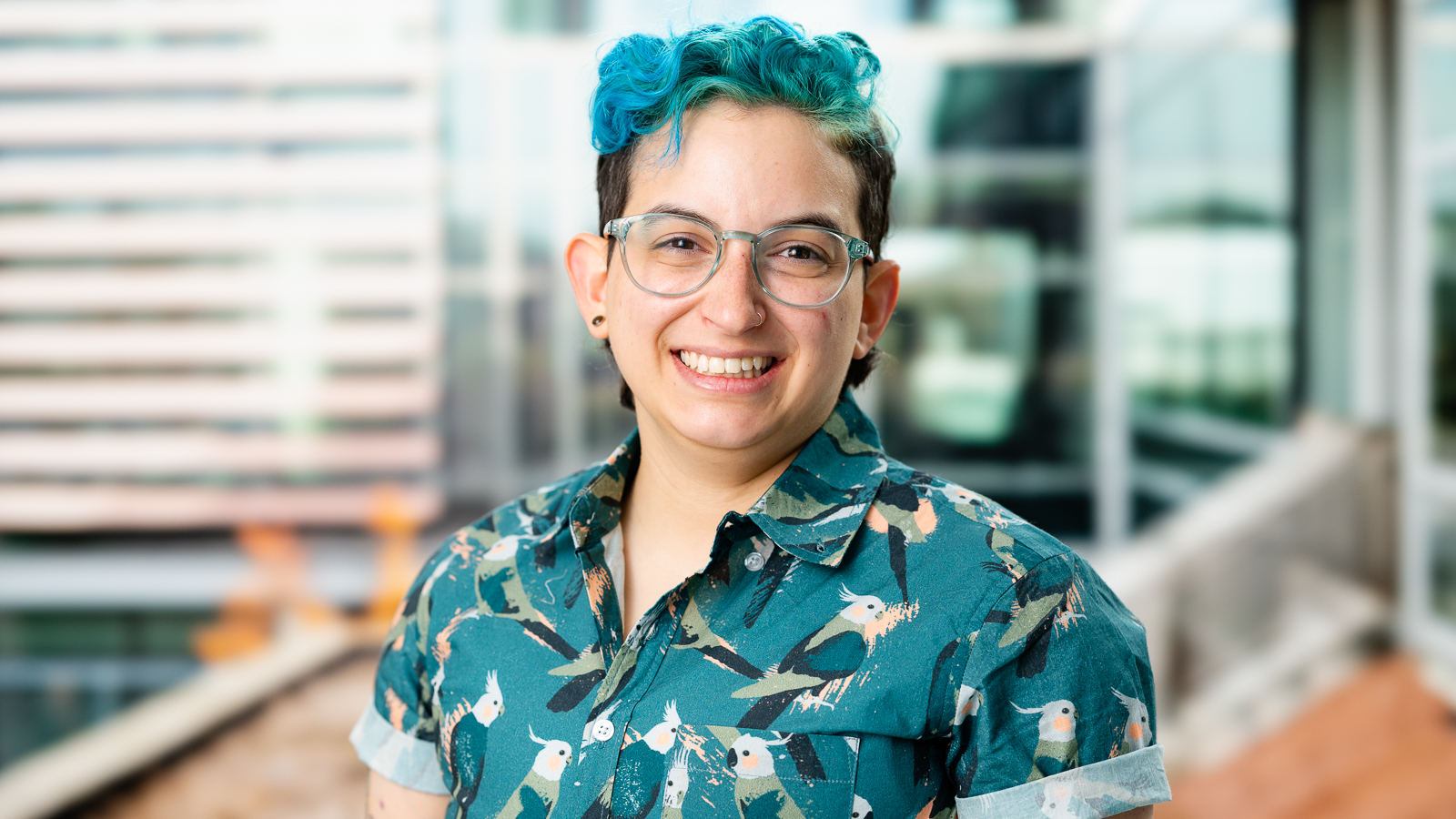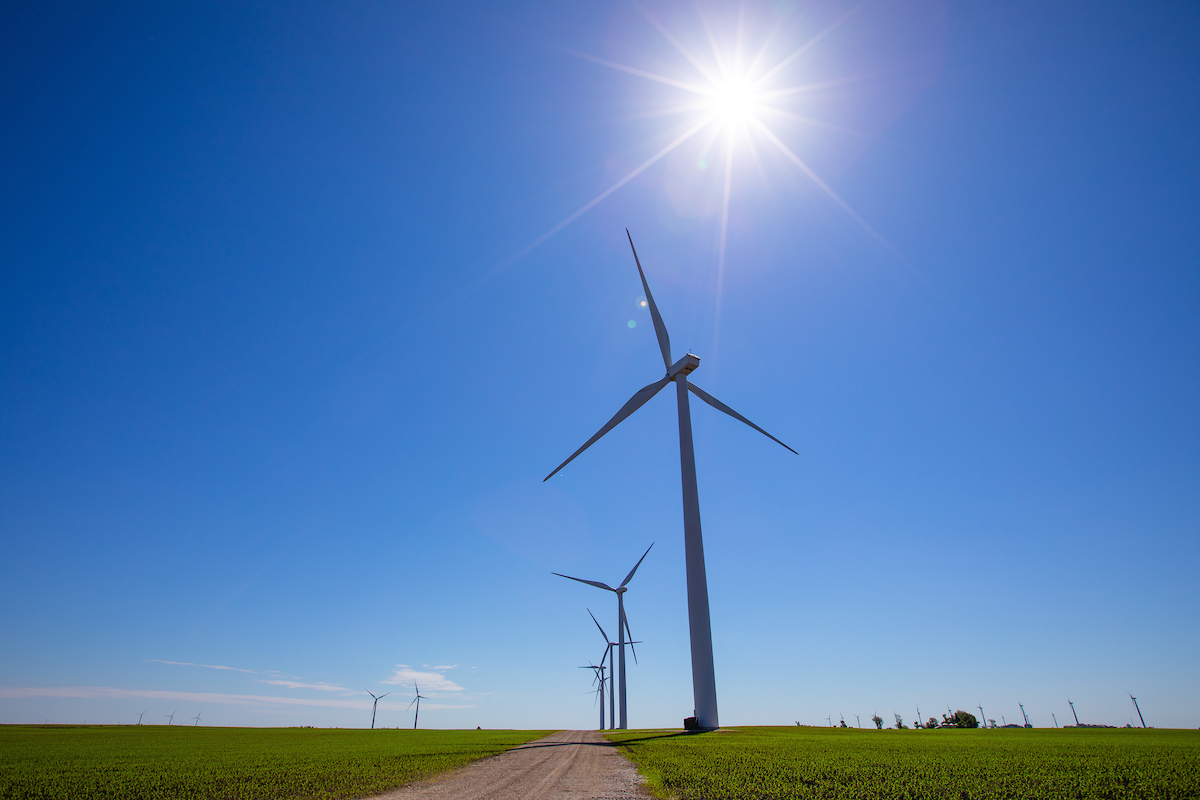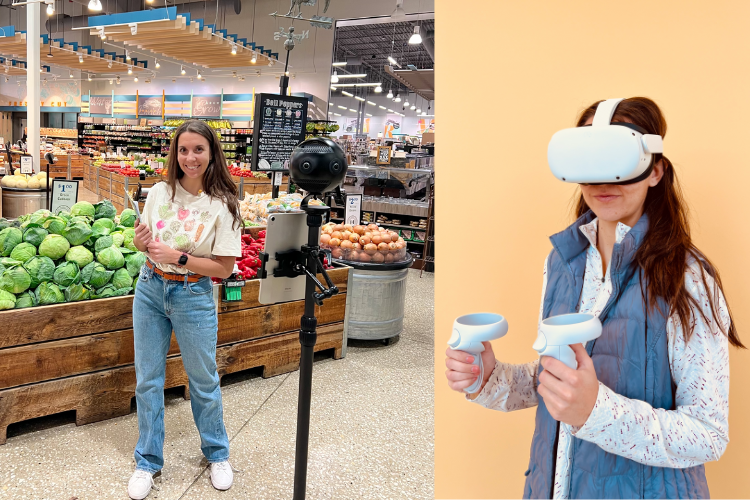“Until then, I had not been to a national lab. I barely even knew about national labs,” Laudadio said. “It was really eye-opening to me to learn what kind of complex science was within my grasp.”
From that moment, they became interested in working for Argonne. That goal came to fruition after Laudadio completed their Ph.D. in chemistry at the University of Wisconsin and joined the lab’s Chemical and Fuel Cycle Technologies division as a postdoctoral researcher in 2020. In the fall of 2022, Laudadio became a Walter Massey Fellow. Here, they describe their research on material coatings for clean energy and what it’s like to be at Argonne.
“I like to think about my research as part of creating a sustainable future and ensuring the longevity of these green energy solutions.” — Liz Laudadio, Argonne Scholar
Q. What are you working on at Argonne?
A. My work has to do with designing coatings for materials to prevent corrosion in particularly extreme environments. So we’re thinking of places like molten salt reactors for nuclear energy or concentrated solar generators, which use mirrors to harvest the sun’s heat. In both cases, you’re trying to collect heat and move it very efficiently. Molten salts are good at moving heat, but they can also be really corrosive when they come into contact with other materials like metals, due to impurities that can be hard to completely filter out.
I am developing these protective coatings for materials using a thin-film growth technique called atomic layer deposition. And I’m bringing in some of my expertise in in situ surface characterization — describing how a material’s topmost layer behaves in its environment — to get an idea of chemical transformations at that level in the early stages of corrosion.
Q. What kinds of materials are you working with?
A. One is stainless steel, which is commonly used for everything from parts of nuclear reactors to cars and buildings. We’re also working with aluminum alloys, for example, which nuclear test reactors use in their cladding — the protective casing around the fuel.
Q. Why is this work important?
A. My work involves basic science, but it has a tangible purpose, which is trying to figure out energy solutions for the future. We are all feeling the effects of climate change at this point. We understand the need to reduce reliance on fossil fuels. One clean energy source that is already very well established is nuclear energy. There is a lot of research going into the next generation of reactors to make nuclear energy even more efficient and produce even less waste. Apart from that, of course, there is always the question of waste and how to make sure the process is as efficient and clean as possible. One way to do that is to ensure that the system’s infrastructure is stable and that the reactors can have long lifetimes. Repairing or replacing equipment is not only a time and cost investment but is also something that produces more waste. So, I like to think about my research as part of creating a sustainable future and ensuring the longevity of these green energy solutions.
Q. What appealed to you about the Walter Massey Fellowship?
A. When I saw the fellowship announcement, it seemed like an excellent opportunity to expand on what I had learned as a postdoc at Argonne. To be able to create my own research program and get that funded was huge. I also wanted to be able to bring something new to the Chemical and Fuel Cycle Technologies division.
Q. What do you like about your work, from a day-to-day perspective?
A. Working at Argonne is such a phenomenal and unique experience. There’s just something really fantastic about working in a space with so many incredible minds — having the ability to form connections and collaborations and new projects with so many different types of scientists and engineers. The cutting-edge facilities that we have, combined with the pure brain power of the people who work here, make for an exciting learning and working environment.
Q. Were you always into science?
A. It wasn’t until later on in high school that I became more interested. Honestly, it was probably television shows involving forensic science like “Law and Order” that really got me into it, which I think is true for a lot of people. It was the first introduction I had to the idea of using science to solve a mystery.
As I gained more experience in science, I realized that there are so many mysteries science aims to solve every day. It’s not just the more clear-cut or obvious mysteries, like the ones in forensic science, but fundamental mysteries of how the universe works and how to use science to create a better world. Each of those things is sort of its own little mystery. I became really interested in research and the idea of having a profession where I was doing something different every day, learning every day, working with my hands and working with my brain.
I credit a lot of my career path to my chemistry professor as an undergraduate at Mount Holyoke College in Massachusetts. I also ended up doing research in her laboratory. She helped me see that I could pursue not only a career in science, but an advanced degree in science, and that that path was available to me. I don’t know that I would have seen it for myself without the way that she mentored me and helped me gain confidence.
Q. What do you do for fun when you’re not in the lab?
A. I enjoy spending time with my dog. She loves playing fetch, so we go to the dog park whenever we can. I’m also part of Argonne’s gardening club, which makes plots of land available on campus. I had never gardened before at all, but last year I had a 10-by-15-foot plot and grew vegetables for the first time in my life. It was such an exciting and fun thing to be able to come to work and check the garden out every morning. I’m looking forward to gardening again this summer. The Argonne campus is so beautiful for walking, running and biking around, so that’s really great too.
Q. What do you want to achieve by the end of this fellowship?
A. I’m hoping to collect fundamental knowledge that can provide some sort of ground rules for how materials will react in different conditions and why. I’m working with a lot of nuclear engineers — people who are actually creating the systems that I am studying on a fundamental level. What I really want to bring to the field and to my colleagues at Argonne is an ability to complement systemic, large-scale engineering information with this fundamental understanding of different materials.
Argonne National Laboratory seeks solutions to pressing national problems in science and technology. The nation’s first national laboratory, Argonne conducts leading-edge basic and applied scientific research in virtually every scientific discipline. Argonne researchers work closely with researchers from hundreds of companies, universities, and federal, state and municipal agencies to help them solve their specific problems, advance America’s scientific leadership and prepare the nation for a better future. With employees from more than 60 nations, Argonne is managed by UChicago Argonne, LLC for the U.S. Department of Energy’s Office of Science.
The U.S. Department of Energy’s Office of Science is the single largest supporter of basic research in the physical sciences in the United States and is working to address some of the most pressing challenges of our time. For more information, visit https://energy.gov/science.




